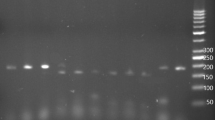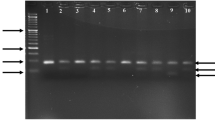Abstract
The role of the paraoxonase (PON1) codon 192 polymorphism [glutamine (Q)/arginine (R)] in coronary artery disease (CAD) is controversial. The aim of the present study was to evaluate whether the PON1 gene polymorphism is an independent risk factor for severity of coronary artery disease in patients from west of Iran. The PON1-Arg-192 genotypes were detected by PCR-RFLP in 414 individuals undergoing their first coronary angiography. Patients were placed into one of two groups: CAD and control without CAD or diabetes. The frequency of PON1-Arg-192 allele was significantly higher in the CAD (23.4 vs. 16%, P = 0.032) than in the control group and there was a higher risk of developing CAD (OR = 1.6, P = 0.02). In addition, this difference remained significant after adjustment for without history of diabetes (OR = 1.47, P = 0.048), presence of normolipidemia and absence of history of blood pressure (OR = 1.4, P = 0.05). This result indicated PON1-Arg-192 allele is a risk factor of CAD also when correcting for conventional risk factors. We found a significant association between the PON1-Arg-192 genotype (QR + RR) and the extent of CAD in CAD patients and CAD subjects without diabetes, represented by the increased frequency of three-vessel disease with OR = 1.49, P = 0.046; χ2 = 3.82, P = 0.048 and OR = 1.46, P = 0.05; χ2 = 3.48, P = 0.051, respectively. The CAD patients carrying PON1-Arg-192 genotype (QR + RR) had lower plasma HDL-C level (P = 0.019) and higher plasma LDL-C(P = 0.01) and TG(P = 0.05). Our results indicated that PON1-Arg-192 allele can be important independent risk factor of CAD in a west population of Iran, with carriers of PON1-Arg-192 having an increased frequency of three-vessel disease and also having a distinct plasma lipids profile. Larger collaborative studies are needed to confirm these results.
Similar content being viewed by others
References
Kharrazi H, Vaisi-Raygani A, Sabokroh AR, Pourmotabbed T (2006) Association between apolipoprotein E polymorphism and coronary artery disease in the Kermanshah population in Iran. Clin Biochem 39:613–616
Vaisi-Raygani A, Rahimi Z, Nomani H, Tavilani H, Pourmotabbed T (2007) The presence of apolipoprotein ε4 and ε2 alleles augments the risk of coronary artery disease in type 2 diabetic patients. Clin Biochem 40:1150–1156
Rahimi Z, Vaisi-Raygani A, Pourmotaabed T (2010) Association between apolipoprotein ε4 allele, factor V Leiden, and plasma lipid and lipoprotein levels with sickle cell disease in Southern Iran. Mol Biol Rep 37(4):2083–2091
Vaisi Raygani A, Rahimi Z, Entezami H, Kharrazi H, Bahrhemand F, Tavilani H, Rezaei M, Kiani A, Nomanpour B, Tavilani H, Pourmotabbed T (2008) Butyrylcholinesterase K ariants increase the risk of coronary artery disease in the population of western Iran. Scand J Clin Lab Invest 68(2):123–129
Vaisi Raygani A, Rahimi Z, Tavilani H, Pourmotabbed T (2010) Butyrylcholinesterase K variant and the APOE-ε4 allele work in synergy to increase the risk of coronary artery disease especially in diabetic patients. Mol Bio Rep 37(4):2083–2091
Vaisi Raygani A, Tavilani H, Zahrai M, Rahimi Z, Sheikh N, Aminian M, Pourmotabbed T (2009) Serum butyrylcholinesterase activity and phenotype associations with lipid profile in stroke patients. Clin Biochem 42:210–214
Hatmi ZN, Tahvildari S, Gafarzadeh Motlag A, Sabouri Kashani A (2007) Prevalence of coronary artery disease risk factors in Iran: a population based survey. BMC Cardiovasc Disord 7(32):1–5
Imazio M, Bobbio M, Bergerone S, Barlera S, Maggioni AP (1998) Clinical and epidemiological characteristics of juvenile myocardial infarction in Italy: the GISSI experience. J Ital Cardiol 28(5):505–512
Antikainen M, Murtomaki S, Syvanne M, Pahlman R, Tahvanainen E, Jauhi-ainen M (1996) The Gln-Arg 191 polymorphism of the human paraoxonase gene (HUMPONA) is not associated with the risk of coronary artery disease in Finns. J Clin Invest 98:883–885
Gupta N, Gill K, Singh S (2009) Paraoxonases: Structure, gene polymorphism & role in coronary artery disease. Indian J Med Res 130:361–368
Zama T, Murata M, Matsubara Y, Kawano K, Aoki N, Yoshina H et al (1997) A 192Arg variant of the human paraoxonase (HUMPONA) gene polymorphism is associated with an increased risk for coronary artery disease in Japanese. Arterioscler Thromb Vasc Biol 17:3565–3569
Pfohl M, Koch M, Enderle MD, Kühn R, Füllhase J, Karsch KR, Häring HU (1999) Paraoxonase 192 Gln/Arg gene polymorphism, coronary artery disease, and myocardial infarction in type 2 diabetes. Diabetes 48:623–627
Koubaa N, Nakbi A, Hammami S, Attia N, Mehri S, Hamda K, Farhat M, Miled A, Hammami M (2009) Association of homocysteine thiolactonase activity and PON1 polymorphisms with the severity of acute coronary syndrome. Clin Biochem 42:771–776
Davies HG (1996) The effect of the human serum paraoxonase polymorphism is reversed with diazoxon, soman and sarin. Nat Genet 14:334–336
La Du BN (1996) Structural and functional diversity of paraoxonases. Nat Med 2:1186–1187
Aviram M (1999) Does paraoxonase play a role in susceptibility to cardiovascular disease? Mol Med Today 5:66–78
Osei-Hyiaman D, Hou L, Mengbai F, Zhiyin R, Zhiming Z, Kano K (2001) Coronary artery disease risk in Chinese type 2 diabetics: is there a role for paraoxonase 1 gene (Q192R) polymorphism? Eur J Endocrin 144:639–644
Ruiz J, Blanche H, James RW, Garin MC, Vaisse C, Charpentier G, Cohen N, Morabia A, Passa P, Froguel P (1995) Gln-Arg192 polymorphism of paraoxonase and coronary heart disease in type 2 diabetes. Lancet 346:869–872
Mohamed RH, Mohamed RH, Karam RA, Abd El-Aziz TA (2010) The relationship between paraoxonase1-192 polymorphism and activity with coronary artery disease. Clin Biochem 43:553–558
Aydin M, Gokkusu C, Ozkok E, Tulubas F, Unlucerci Y, Pamukcu B, Ozbek Z, Umman B (2009) Association of genetic variants in methylenetetrahydrofolate reductase and paraoxonase-1 genes with homocysteine, folate and vitamin B12 in coronary artery disease. Mol Cell Biochem 325:199–208
Odawara M, Tachi Y, Yamashitya K (1997) Paraoxonase polymorphism (Gln192-Arg) is associated with coronary heart disease in Japanese noninsulin-dependent diabetes mellitus. J Clin Endocrinol Metab 82:2257–2260
Serrato M, Marian AJ (1995) A variant of human paraoxonase/arylesterase (HUMPONA) gene is a risk factor for coronary artery disease. J Clin Invest 96:3005–3008
Taskıran P, Cam SF, Sekuri C, Tuzun N, Alioglu E, Altıntas N, Berdeli A (2009) The relationship between paraoxanase gene Leu-Met (55) and Gln-Arg (192) polymorphisms and coronary artery disease. Arch Turk Soc Cardiol 37(7):473–478
Suehiro T, Nakauchi Y, Yamamoto M, Arii K, Itoh H, Hamashige N, Hashimoto K (1996) Paraoxonase gene polymorphism in Japanese subjects with coronary heart disease. Int J Cardiol 57:69–73
Sanghera DK, Saha N, Aston CE, Kamboh MI (1997) Genetic polymorphism of paraoxonase and the risk of coronary heart disease. Arterioscler Thromb Vasc Biol 17:1067–1073
Herrmann SM, Blanc H, Poirier O, Arveiler D, Luc G, Evans A, Marques Vidal P, Bard JM, Cambien F (1996) The Gln/Arg polymorphism of human paraoxonase (PON 192) is not related to myocardial infarction in the ECTIM study. Athersclerosis 126:299–303
World Health Organization (1999) WHO Study Group Report of a WHO consultation: part 1. Diagnosis and classification of diabetes mellitus. World Health Organization, Geneva
Johan SWM, Weitzner G, Rozen R (1991) A rapid procedure for extracting genomic DNA from leukocytes. Nucleic Acids Res 19:408
Crow JF (1999) Hardy, Weinberg and language impediments. Genetics 152(3):821–825
Heijmans BT, Westendorp RG, Lagaay AM, Knook DL, Kluft C, Slagboom PE (2000) Common paraoxonase gene variants, mortality risk and fatal cardiovascular events in elderly subjects. Atherosclerosis 149:91–97
Wheeler JG, Keavney BD, Watkins H, Collins R, Danesh J (2004) Four paraoxonase gene polymorphisms in 11212 cases of coronary heart disease and 12786 controls: meta-analysis of 43 studies. Lancet 363:686–695
Debbie T, Lawlor A, Day INM, Gaunt TR, Hinks LJ, Briggs PJ, Kiessling M, Timpson N, Smith GD, Ebrahim S (2004) The association of the PON1 Q192R polymorphism with coronary heart disease: findings from the British Women’s heart and health cohort study and a meta-analysis. BMC Genetics 5(17):1–13
Aviram M, Fuhrman B (1998) LDL oxidation by arterial wall macrophages depends on the oxidative status in the lipoprotein and in the cells: role of prooxidants vs. antioxidants. Mol Cell Biochem 188:149–159
Mackness MI, Arrol S, Durrington PN (1991) Paraoxonase prevents accumulation of lipoperoxides in low-density lipoprotein. FEBS Lett 286:152–154
Tarchalski J, Guzik P, Wysocki H (2003) Correlation between the extent of coronary atherosclerosis and lipid profile. Mol Cell Biochem 246:25–30
Steinberg D, Lewis A (1997) Conner Memorial Lecture. Oxidative modification of LDL and atherogenesis. Circulation 95:1062–1071
Ajmal M, Ahmed W, Sadeque A, Ali SH, Bokhari SH, Ahmed N, Qamar R (2010) Identification of a recurrent insertion mutation in the LDLR gene in a Pakistani family with autosomal dominant hypercholesterolemia. Mol Biol Rep 37(8):3869–3875
AshokKumar M, Subhashini NG, SaiBabu R, Ramesh A, Cherian KM, Emmanuel C (2010) Genetic variants on apolipoprotein gene cluster influence triglycerides with a risk of coronary artery disease among Indians. Mol Biol Rep 37(1):521–527
Rahimi Z, Felehgari V, Rahimi M, Mozafari H, Yari K, Vaisi-Raygani A, Rezaei M, Malek-Khosravi S, Khazaie H (2011) The frequency of factor V Leiden mutation, ACE gene polymorphism, serum ACE activity and response to ACE inhibitor and angiotensin II receptor antagonist drugs in Iranians type II diabetic patients with microalbuminuria. Mol Biol Rep (in press)
Aviram M, Rosenblat M, Bisgaier CL, Newton RS, Primo-Parmo SL, La Du BN (1998) Paraoxonase inhibits high-density lipoprotein oxidation and preserves its functions: a possible peroxidative role for PON1. J Clin Invest 101:1581–1590
Tabur S, Torun AN, Sabuncu T, Turan MN, Celik H, Ocak AR, Aksoy N (2010) Nondiabetic metabolic syndrome and obesity do not affect serum paraoxonase and arylesterase activities but do affect oxidative stress and inflammation. Eur J Endocrinol 162(3):535–541
Mackness B, Mackness MI, Arrol S, Turkie W, Durrington PN (1998) Effect of the human serum PON1 55 and 192 genetic polymorphisms on the protection by high density lipoprotein against low density lipoprotein oxidative modification. FEBS Lett 423:57–60
Acknowledgments
This work was supported by the Kermanshah University of Medical Sciences, Kermanshah, Iran (grant numbers 86049); All authors contributed equally to this study. This research did not receive any specific grant from any funding agency in the public, commercial or not-for-profit sector.
Conflict of interest
None.
Author information
Authors and Affiliations
Corresponding author
Rights and permissions
About this article
Cite this article
Vaisi-Raygani, A., Ghaneialvar, H., Rahimi, Z. et al. Paraoxonase Arg 192 allele is an independent risk factor for three-vessel stenosis of coronary artery disease. Mol Biol Rep 38, 5421–5428 (2011). https://doi.org/10.1007/s11033-011-0696-3
Received:
Accepted:
Published:
Issue Date:
DOI: https://doi.org/10.1007/s11033-011-0696-3




